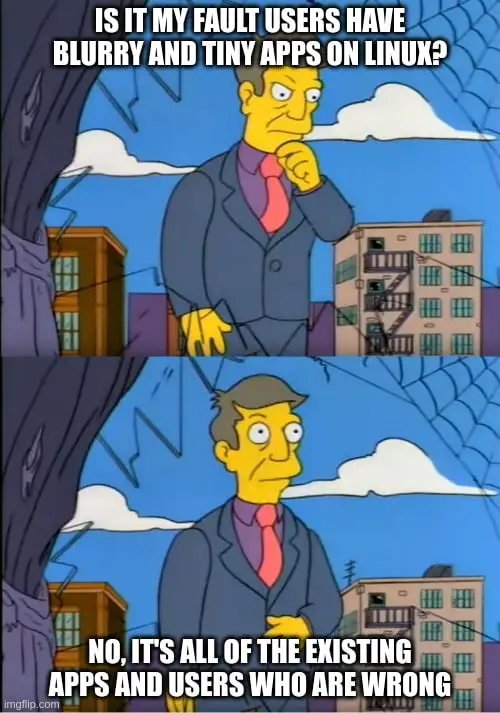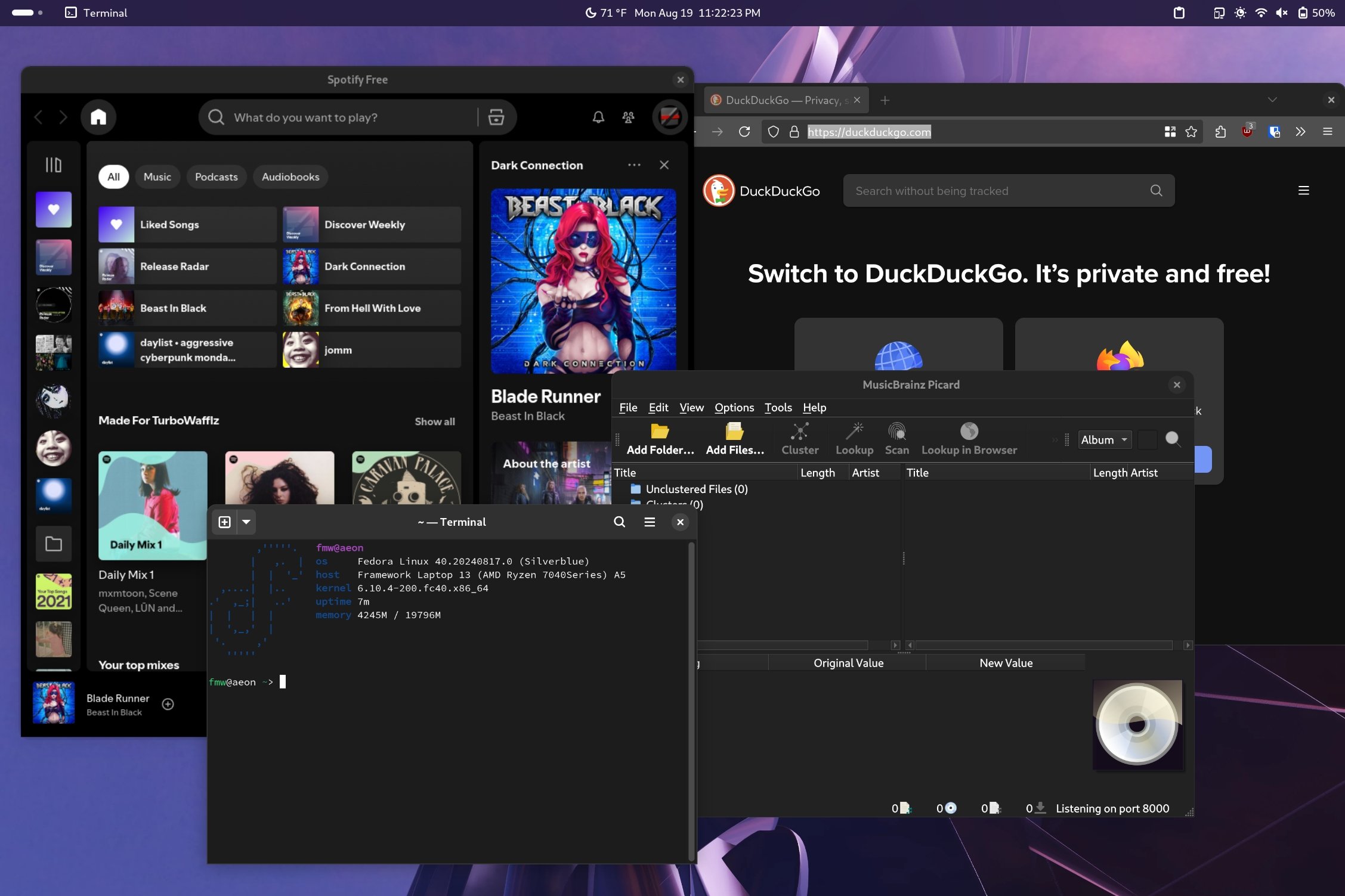Wuuttup. I’m here complaining again about Framework’s Linux unfriendly display. The new one this time.
https://frame.work/products/display-kit?v=FRANJF0001
Old display, 2256 x 1504 (3:2)
GNOME
100% scale
- Nothing looks blurry
- Everything is tiny
- Unusable
100% scale + large text accessibility
- Nothing looks blurry
- Most apps scale appropriately
- Some apps don’t respect GNOME’s large text setting (Alacritty)
125% scale
- Most apps look blurry (Picard, Firefox, Spotify, Alacritty)
200% scale
- Everything is way too big
- Unusable
Plasma
100% scale
- Nothing looks blurry
- Everything is tiny
- Unusable
125% scale + Apply scaling themselves
- Nothing looks blurry
- Most apps scale appropriate
- Some apps can’t scale themselves and look tiny (Picard)
125% scale + Scaled by system
- Most apps look blurry (Picard, Firefox, Spotify, Alacritty)
200% scale
- Everything is way too big
- Unusable
New display, 2880 x 1920 (3:2)
GNOME
100% scale
- Nothing looks blurry
- Everything is tiny
- Unusable
100% scale + large text accessibility
- Nothing looks blurry
- Most apps scale appropriately
- Some apps don’t respect GNOME’s large text setting (Alacritty)
- Everything is tiny
150% scale
- Most apps look blurry (Picard, Firefox, Spotify, Alacritty)
200% scale
- Everything is way too big
- Unusable
Plasma
100% scale
- Nothing looks blurry
- Everything is tiny
- Unusable
150% scale + Apply scaling themselves
- Nothing looks blurry
- Some apps can’t scale themselves, but look a little better here? (Picard)
150% scale + Scaled by system
- Most apps look blurry (Picard, Firefox, Spotify, Alacritty)
200% scale
- Everything is way too big
- Unusable
tl;dr
In the old display, GNOME at 100% + large text was the best compromise. In the new display, Plasma at 150% + Apply scaling themselves is the best compromise.
Interestingly, Picard scaling itself looks super tiny in the old display, but in the new display it looks… better. It’s still not correctly scaled like native Wayland apps, but it’s better.
Warning
If you can’t stomach moving from GNOME to Plasma, then 🚨 DO NOT BUY THE NEW DISPLAY 🚨. The new display is worse for GNOME.
Once again
I am once again begging Framework to just give us a damn regular DPI display that works! Without workarounds. Without forcing users on specific DEs. Without forcing users to stop using their favorite apps. This new display has basically all of the flaws as the previous one.
I am once again begging Framework to just give us a damn regular DPI display that works!
Bottom Skinner is right, though. It’s 2024. HiDPI has to be supported by all toolkits, desktops, and applications at this point. There are no excuses. Even 1080p on a 14" laptop screen warrants 125% scaling, IMO.
“This hardware works fine and even has compatible software that it works great with. But I’m going to prefer the broken software for other reasons. And that means it’s the hardware’s fault.”
Software that is built to be compatible with a wide variety of hardware should be compatible with a wide variety of hardware.
If software can’t handle a 16.5:16 aspect ratio, then that’s bad software. I don’t care how weird of a niche thing that is… just make your software abstract enough to handle those cases.
It’s 2024, any resolution/aspect ratio/DPI combo should be supportable. There’s enough variety of monitors out there that we should have a solution for handling things on the fly without needing to have a predefined solution.
🤣on 14” 1080 i would need 50% scaling to make it usable for me, since I can not work with such a tiny space for my apps… You can’t even use two apps side by side on 1080 these days, since everything is designed for higher DPI.
And even on 100% is the font so blurry that it is hard to read. Got do I hate 1080p 🤣🤣
Everything I use needs high DPI like 2k to 3k on 14” - 16”, everything bigger needs at least 4k
I get needing more space for certain workflows but if fonts are blurry on 1080p at 100% there’s something wrong with your setup. Misconfigured font renderer or so. Configure your FreeType to set font smoothing to sharp and hinting to slight. If your distribution has other defaults, file a bug report with them. Back in the day when screens had a lower pixel density (I had 15" 720p once), FreeType might have been configured “smoother” because it would match print output closer.
I have no Linux on any 1080 screen… There were a test laptop With 1080p in my office (windows) and we still have some 1200p screen in use (I avoid them)
The Font is definitely why better readable on 4k, even at half the size compared to 1080p
HiDPI has to be supported by all toolkits, desktops, and applications at this point. There are no excuses.
I mean… yeah, I agree. Would you mind sending that email to the millions of devs around the world? Not sure if they’re aware of this.
I just want to be able to read my screen. 😭
Would you mind sending that email to the millions of devs around the world?
Yes, I mind. For Qt5 applications, basic HiDPI support can be patched in with a single line. I actually did that for a handful of applications, tested them, and then submitted pull requests on Github. I cannot program, so all I could do is to copy and paste that one line from the Qt documentation. It’s not much but I already did my part.
So hardware manifacturers need to adapt to XOrg now? LOL the reason that some apps dont scale right even on Plasma is that they are probably not Wayland native yet.
And GNOME still doesnt have stable fractional scaling, unlike Plasma.
Hardware vendors shouldnt need to adapt to GNOME too.
Woopsie
I finally stopped having problems on Wayland plasma after the release some months ago that included fixes to fractional scaling. Me after many months and years complaining about wayland not working properly now can say that I can barely notice the difference and things work as expected. Had to cry to make discord and zoom work for screen share and zoom still crashes but at least kinda works. But that’s different than blurry fonts at least 😅
Blurry apps come from xwayland compatibility. Firefox and alacritty (or other terminal like wezterm or kitty) have native wayland, with no blurry check Archwiki for example HiDPI. With Spotify, live with it or use spot (gtk client). Hopefully next gnome release incorporate something like plasma, and then ctrl+ native in spotify increase its size.
Or use spotify from the browser
Blurry and tiny apps come from Framework’s poor choice of display. Other laptops don’t have this problem.
Yes, I’m aware of software-side issues, but it’s still their fault for seeing the software issues and then picking a broken display anyway.

Other laptops don’t have this problem.
You can’t be serious. It’s 2024, and my laptop from 10 years ago needs 125% scaling at least. Get real.
Meme is right, in 2024 poor HiDPI scaling is a software issue
I have basically zero issues with fractional scaling with Gnome on Wayland, I thing you probably have something configured wrong.
Here’s a screenshot of how a few programs look for me with 125% scaling on my original framework display. The only thing slightly blurry is spotify but it’s not enough to be noticeable in normal use.

Edit: Looks like lemmy actually compressed my screenshot a fair bit but I think you can still tell that things are scaling properly
You can launch spotify under native wayland instead of xwayland, it gives scaling without blur
https://wiki.archlinux.org/title/Spotify#Running_under_Wayland
this way works for all electron programs like discord, motrix
Ayy, beast in black! Saw those guys live (and barely knew them, lol). They make good music (their “beast in black” song seems to be my favourite).
😮i already was happy finding a new dubstep artist seeing that cover only zo find out that it was metal🤣
Hahahaha yeah, its power metal
96 DPI should be a choice, agreed. But it’s a software issue when an app or a framework doesn’t display well on HIDPI.
Agreed! Not saying it’s not a software issue. Of course the software is broken. Of course I wish it was updated.
But, Framework seeing the landscape and picking hardware with known issues is a bad choice. They could offer lower DPI and eliminate entire pages of workarounds and half fixes.
Yes, high DPI should work, but it doesn’t everywhere. That’s just the reality, I wish it wasn’t.
Hardware should lead. It’s easier to upgrade the software to make the hardware work, then it is to upgrade the hardware when the software decides to support it.
scaled by system/themselves … looks like those are x11 apps. why is firefox into this? run it as native wayland with
MOZ_ENABLE_WAYLANDNot necessary anymore with current version Firefox. It has Wayland enabled by default now.
Sexy
You want hardware manufacturers to provide shitty screens in perpetuity just so Linux devs can avoid implementing proper scaling? Yeah, no.
I really hope that all Linux desktop software gets scaling support soon. Can’t live with only integer scaling increments
Just to make sure, have you logged out and back in after applying the scaling? Some apps look blurry until you do that. Try to avoid quarter scaling, no x25% or x75%…
You should try 110% and 130%. Dunno if it’s the 5’s but those seem to work better for me.
Is it that bad? I run gnome on two 4k monitors with 100% scaling and large text and it’s great
Thanks for the write up. I was in a similar situation with a 4k 14 inch Dell something, instead of scaling at 200%, I lowered the resolution to half at 1080p and it worked flawlessly. Maybe you could try it too?
The issue here is that some apps don’t support scaling, so they show in a lower resolution, making them look blurry.
Your solution just makes everything do that.Nope, it wasn’t blurry. In principle, I lose some DPI goodness, but it didn’t make any difference to me on my daily usage of the laptop
How are you feeling about the Framework otherwise?
It’s all right otherwise. Not phenomenal, but not crap. The specs you can get with other laptops. The hardware feel isn’t as good as a Dell XPS or an X1 Carbon. The expansion card stuff is kinda cool, but other laptops have ports too. I’ve never swapped out the cards.
The main reason I bought this laptop is repairability. If that’s not your main priority, then I probably wouldn’t recommend this laptop.
If you want to use this laptop with Linux and not spend time fixing hardware compatibility issues, then I definitely would not recommend this laptop. Definitely get a Dell XPS for a Linux laptop that Just Works.
Appreciate you taking the time, thanks.
I agree with pretty much everything they’ve said, though I’ve gotten more use out of the swappable parts. I have a desktop I use for things I need a powerful system for, but being able to swap in the GPU when traveling is great.
When I’m at home I have basically everything on USB C and the empty expansion bay.
When I travel I swap in the GPU and add an HDMI port and some USB a ports.
If you don’t have stuff set up like I do I agree it’s mostly just a reparability / upgradeability thing.
Framework would be an instant buy for me if not the 3:2 screen. I’m not a developer, so there’s no upside for me
I just want the repairability
If you want to use this laptop with Linux and not spend time fixing hardware compatibility issues, then I definitely would not recommend this laptop. Definitely get a Dell XPS for a Linux laptop that Just Works.
Have you tried the
-frameworkimages from uBlue?
My exposure to Linux is pretty minimal, especially Linux with a GUI, so forgive my ignorance. Even reading over this thread I’m confused as to the issue here.
I don’t need an ELI5, but maybe someone can explain it like I don’t know what Wayland is?
My understanding is that an app should ask the system to display an object at X size, let’s say text at size 14. The system then works out that at the currently selected display resolution, size 14 will be Y pixels big. If needed, the system can scale that based on user preferences- a small, high DPI screen could render size 14 at only a couple of millimetres, for example.
Is the problem that devs are building things in a way that bypasses scaling? For example, hardcoding size 14 text to be Z pixels high?
That is basically the problem. Also that fractional scaling on Linhx generally still gives blurry results. Fractional scaling without explicit support from the apps side is very difficult to implement.
And yes, there are a ton of of apps that don’t correctly respect OS hints for size. Even more common among apps that aren’t Linux first, or are proprietary.











